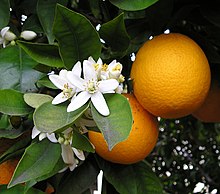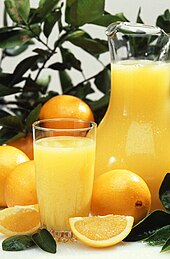橙:修订间差异
如何滥用橙 标签:手工回退 |
|||
| 第13行: | 第13行: | ||
在 2017年,全球一共生长了7300万[[吨]]的橙,其中巴西就生长了其中的 24% ,紧接着的是中国和印度。<ref name="fao17">{{cite web|title=Production of oranges, 2017 – choose "Production, Crops, World Regions" in the left margin and picklist |url=http://www.fao.org/faostat/en/#data/QC|publisher=United Nations, Food and Agricultural Organization, FAO Statistics|date=2018|access-date=2019-07-23}}</ref> |
在 2017年,全球一共生长了7300万[[吨]]的橙,其中巴西就生长了其中的 24% ,紧接着的是中国和印度。<ref name="fao17">{{cite web|title=Production of oranges, 2017 – choose "Production, Crops, World Regions" in the left margin and picklist |url=http://www.fao.org/faostat/en/#data/QC|publisher=United Nations, Food and Agricultural Organization, FAO Statistics|date=2018|access-date=2019-07-23}}</ref> |
||
== |
== 历史 == |
||
[[File:Yellow Oranges and Green Tangerines (橙黃橘綠) by Zhao Lingrang (趙令穰).jpg|thumb|upright|《橙黄橘绿》,作者为赵令穰,是[[宋朝]]的扇子画,目前位于[[国立故宫博物院|NPM]]。]] |
|||
* [[甜橙]] |
|||
甜橙不是一种野果,<ref name=webber4 /> 归因于不纯的[[橘子]]与杂种[[柚]]之间的杂交,而杂种[[柚]]具有大量柑的基因。由于其叶绿体DNA是柚子的叶绿体DNA,因此它可能是杂种柚子。它也许是BC1柚子{{le|回交|Backcrossing}}的产物,是第一个橙的母本。 <ref name=genealogy_review /><ref name=Wu>{{cite journal |title=Sequencing of diverse mandarin, pomelo and orange genomes reveals complex history of admixture during citrus domestication |journal=Nature Biotechnology |author=G Albert Wu|display-authors=etal |volume=32 |issue=7 |doi=10.1038/nbt.2906 |pages=656–662 |pmid=24908277 |pmc=4113729|year=2014 }}</ref> 根据基因组分析,甜橙中祖先物种的相对比例约为42%的柚子和58%的柑。 <ref name="Talon">{{cite journal|title=Genomics of the origin and evolution of ''Citrus'' | last1=Wu | first1=Guohong Albert | last2=Terol | first2=Javier | last3=Ibanez | first3=Victoria | last4=López-García | first4=Antonio | last5=Pérez-Román | first5=Estela | last6=Borredá | first6=Carles | last7=Domingo | first7=Concha | last8=Tadeo | first8=Francisco R | last9=Carbonell-Caballero | first9=Jose | last10=Alonso | first10=Roberto | last11=Curk | first11=Franck | last12=Du | first12=Dongliang | last13=Ollitrault | first13=Patrick | last14=Roose | first14=Mikeal L. Roose | last15=Dopazo | first15=Joaquin | last16=Gmitter Jr | first16=Frederick G. | last17=Rokhsar | first17=Daniel | last18=Talon | first18=Manuel | journal=Nature | year = 2018 | volume=554 | issue=7692 | pages=311–316 | doi=10.1038/nature25447 | pmid=29414943| bibcode=2018Natur.554..311W | doi-access=free }} and Supplement</ref> 甜橙的所有变种都来自这个原始的杂交品种,仅在农业繁殖过程中选择的突变有所不同。 <ref name=Wu /> 甜橙的起源与苦橙的起源截然不同,苦橙是由纯橘子和柚子亲本杂交而成的,也许它是在野生环境中独立产生的。 <ref name=Wu /> 最早描述甜橙的中国文献来自公元前 314 年。<ref name=fullgenome /> |
|||
* [[柑橘属]] |
|||
在欧洲,[[摩尔人]]将橙引入[[伊比利亚半岛]](当时的[[安达卢斯]]),从10世纪开始大规模种植。这一点已通过专门用于种植橙果园的复杂灌溉技术得到证明。 <ref>{{cite web|url=http://canal.ugr.es/prensa-y-comunicacion/science-news-ugr/social-economic-and-legal-sciences/sugar-cane-cumin-and-orange-grove-crops-were-adapted-in-alandalus-from-the-10th-century/|title=Water and landscape in Granada|date=1 September 2003|website=Universidad de Granada|last1=Trillo San José|first1=Carmen}}</ref> |
|||
柑橘类水果-其中包括苦橙-在[[西西里酋长国]]时期于9世纪引入西西里岛,但是直到15世纪末或16世纪初,甜橙才广为人知。这时是意大利和葡萄牙商人将橘子树带入地中海地区的时候。 <ref name=morton /> 此后不久,甜橙迅速被用作可食用的水果。它也被认为是奢侈品,有钱人会在私人音乐学校种橘子,称为{{le|orangerie}}。1646年,甜橙在整个欧洲广为人知。 <ref name=morton /> 法国的[[路易十四]]非常喜欢橘子树,并在[[凡尔赛宫]]建造了最宏伟的{{le|凡尔赛宫橘子室|Versailles Orangerie}}。 <ref>{{cite book| title=The Gardens of Versailles| author=Jean-Baptiste Leroux| publisher=Thames & Hudson| year=2002|page=368}}</ref> 在凡尔赛宫,宫殿的整个房间都摆放着用实心银盆栽栽种的橘子树,而橘园则允许全年种植这种水果,以供宫廷使用。 1664年,路易十四谴责其财政部长[[尼古拉斯·富凯]]时,他没收的部分宝藏是位于[[子爵城堡]]的富凯庄园的一千多棵橘树。 <ref>{{cite book| title=The Sun King| author=Nancy Mitford| publisher=Sphere Books Ltd.| year=1966|page=11}}</ref> |
|||
== 参考资料 == |
== 参考资料 == |
||
2021年4月2日 (五) 15:58的版本




橙是一类水果,指任何的柑橘属水果,属于芸香科(参见被称为橙的植物列表),一般指甜橙[1] ,学名Citrus × sinensis以区分一种学名叫做 Citrus × aurantium的植物,也就是苦橙。甜橙会进行无性繁殖,使得各种甜橙通过突变产生。 [2][3][4][5]
橙是柚子 (Citrus maxima) 和 橘 (Citrus reticulata)的杂交种。[2][6] 橙的叶绿体基因组,也就是母系是柚。 [7] 甜橙有自己的完整基因组测序。[2]
橙起源于中国南方,印度东北部和缅甸地区。 [8][9]在公元前314年,中国文献最先描述了甜橙。[2] 截至1987年[update],人们发现橙树是世界上最多的耕作果树。 [10] 橙树大量生长于热带和亚热带地区,以生成橙。橙树的果实,也就是橙可以直接生吃,或是榨成橙汁和有香气的橙皮的来源。[11] 截至2012年[update],甜橙约占柑橘属产量的70%。 [12]
在 2017年,全球一共生长了7300万吨的橙,其中巴西就生长了其中的 24% ,紧接着的是中国和印度。[13]
历史

甜橙不是一种野果,[14] 归因于不纯的橘子与杂种柚之间的杂交,而杂种柚具有大量柑的基因。由于其叶绿体DNA是柚子的叶绿体DNA,因此它可能是杂种柚子。它也许是BC1柚子回交的产物,是第一个橙的母本。 [7][15] 根据基因组分析,甜橙中祖先物种的相对比例约为42%的柚子和58%的柑。 [16] 甜橙的所有变种都来自这个原始的杂交品种,仅在农业繁殖过程中选择的突变有所不同。 [15] 甜橙的起源与苦橙的起源截然不同,苦橙是由纯橘子和柚子亲本杂交而成的,也许它是在野生环境中独立产生的。 [15] 最早描述甜橙的中国文献来自公元前 314 年。[2]
在欧洲,摩尔人将橙引入伊比利亚半岛(当时的安达卢斯),从10世纪开始大规模种植。这一点已通过专门用于种植橙果园的复杂灌溉技术得到证明。 [17] 柑橘类水果-其中包括苦橙-在西西里酋长国时期于9世纪引入西西里岛,但是直到15世纪末或16世纪初,甜橙才广为人知。这时是意大利和葡萄牙商人将橘子树带入地中海地区的时候。 [10] 此后不久,甜橙迅速被用作可食用的水果。它也被认为是奢侈品,有钱人会在私人音乐学校种橘子,称为orangerie。1646年,甜橙在整个欧洲广为人知。 [10] 法国的路易十四非常喜欢橘子树,并在凡尔赛宫建造了最宏伟的凡尔赛宫橘子室。 [18] 在凡尔赛宫,宫殿的整个房间都摆放着用实心银盆栽栽种的橘子树,而橘园则允许全年种植这种水果,以供宫廷使用。 1664年,路易十四谴责其财政部长尼古拉斯·富凯时,他没收的部分宝藏是位于子爵城堡的富凯庄园的一千多棵橘树。 [19]
参考资料
- ^ Citrus ×sinensis (L.) Osbeck (pro sp.) (maxima × reticulata) sweet orange. Plants.USDA.gov. (原始内容存档于2011-05-12).
- ^ 2.0 2.1 2.2 2.3 2.4 Xu, Q; Chen, LL; Ruan, X; Chen, D; Zhu, A; Chen, C; Bertrand, D; Jiao, WB; Hao, BH; Lyon, MP; Chen, J; Gao, S; Xing, F; Lan, H; Chang, JW; Ge, X; Lei, Y; Hu, Q; Miao, Y; Wang, L; Xiao, S; Biswas, MK; Zeng, W; Guo, F; Cao, H; Yang, X; Xu, XW; Cheng, YJ; Xu, J; Liu, JH; Luo, OJ; Tang, Z; Guo, WW; Kuang, H; Zhang, HY; Roose, ML; Nagarajan, N; Deng, XX; Ruan, Y. The draft genome of sweet orange (Citrus sinensis). Nature Genetics. Jan 2013, 45 (1): 59–66. PMID 23179022. doi:10.1038/ng.2472
 .
.
- ^ Orange Fruit Information. 2017-06-09 [2018-09-20].
- ^ Orange fruit nutrition facts and health benefits. [2018-09-20].
- ^ Oranges: Health Benefits, Risks & Nutrition Facts. [2018-09-20].
- ^ Andrés García Lor. Organización de la diversidad genética de los cítricos (PDF) (学位论文): 79. 2013.
- ^ 7.0 7.1 Velasco, R; Licciardello, C. A genealogy of the citrus family. Nature Biotechnology. 2014, 32 (7): 640–642. PMID 25004231. S2CID 9357494. doi:10.1038/nbt.2954.
- ^ Morton, Julia F. Fruits of Warm Climates. 1987: 134–142.
- ^ Talon, Manuel; Caruso, Marco; Gmitter, Jr., Fred G. The Genus Citrus. Woodhead Publishing. 2020: 17. ISBN 9780128122174.
- ^ 10.0 10.1 10.2 Morton, J. Orange, Citrus sinensis. In: Fruits of Warm Climates. NewCROP, New Crop Resource Online Program, Center for New Crops & Plant Products, Purdue University: 134–142. 1987.
- ^ Citrus sinensis. Germplasm Resources Information Network (GRIN). USDA.
- ^ Organisms. Citrus Genome Database
- ^ Production of oranges, 2017 – choose "Production, Crops, World Regions" in the left margin and picklist. United Nations, Food and Agricultural Organization, FAO Statistics. 2018 [2019-07-23].
- ^ 引用错误:没有为名为
webber4的参考文献提供内容 - ^ 15.0 15.1 15.2 G Albert Wu; et al. Sequencing of diverse mandarin, pomelo and orange genomes reveals complex history of admixture during citrus domestication. Nature Biotechnology. 2014, 32 (7): 656–662. PMC 4113729
 . PMID 24908277. doi:10.1038/nbt.2906.
. PMID 24908277. doi:10.1038/nbt.2906.
- ^ Wu, Guohong Albert; Terol, Javier; Ibanez, Victoria; López-García, Antonio; Pérez-Román, Estela; Borredá, Carles; Domingo, Concha; Tadeo, Francisco R; Carbonell-Caballero, Jose; Alonso, Roberto; Curk, Franck; Du, Dongliang; Ollitrault, Patrick; Roose, Mikeal L. Roose; Dopazo, Joaquin; Gmitter Jr, Frederick G.; Rokhsar, Daniel; Talon, Manuel. Genomics of the origin and evolution of Citrus. Nature. 2018, 554 (7692): 311–316. Bibcode:2018Natur.554..311W. PMID 29414943. doi:10.1038/nature25447
 . and Supplement
. and Supplement
- ^ Trillo San José, Carmen. Water and landscape in Granada. Universidad de Granada. 1 September 2003.
- ^ Jean-Baptiste Leroux. The Gardens of Versailles. Thames & Hudson. 2002: 368.
- ^ Nancy Mitford. The Sun King. Sphere Books Ltd. 1966: 11.
外部链接
 维基共享资源上的相關多媒體資源:橙
维基共享资源上的相關多媒體資源:橙 維基物種上的相關信息:橙
維基物種上的相關信息:橙- Citrus sinensis List of Chemicals (Dr. Duke's Phytochemical and Ethnobotanical Databases), USDA, Agricultural Research Service.
- Oranges: Safe Methods to Store, Preserve, and Enjoy. (2006). University of California Agriculture and Natural Resources. Accessed May 23, 2014.
| ||||||||||||||||||||||||||||||||||||||||||||||||||||||||||||||||||||||||||||||||||||||||||||||||||||||||||||||||||||||||||||
